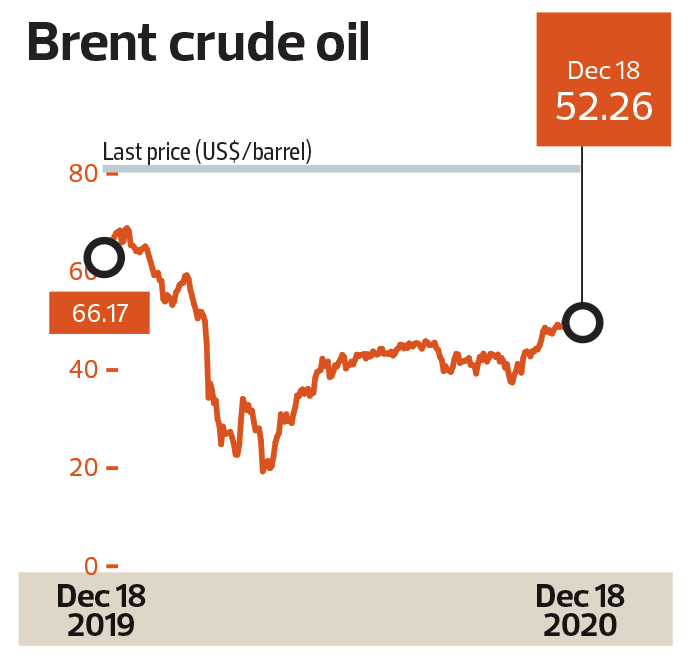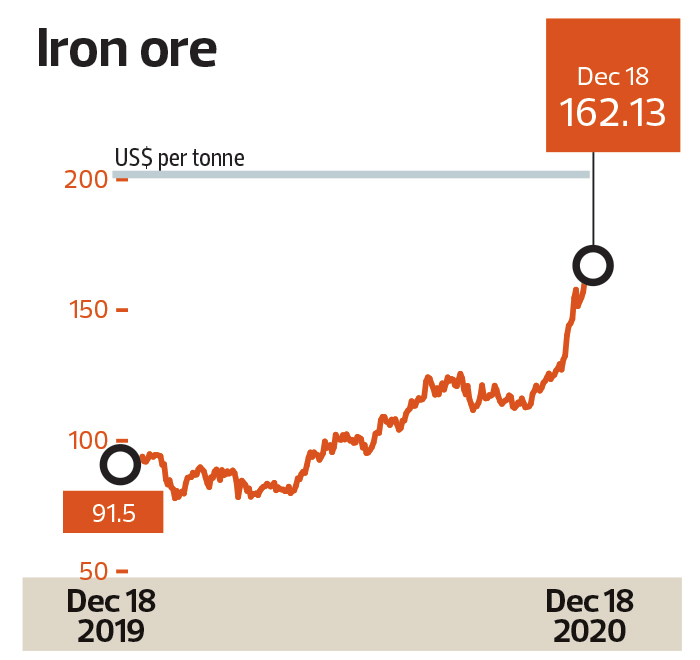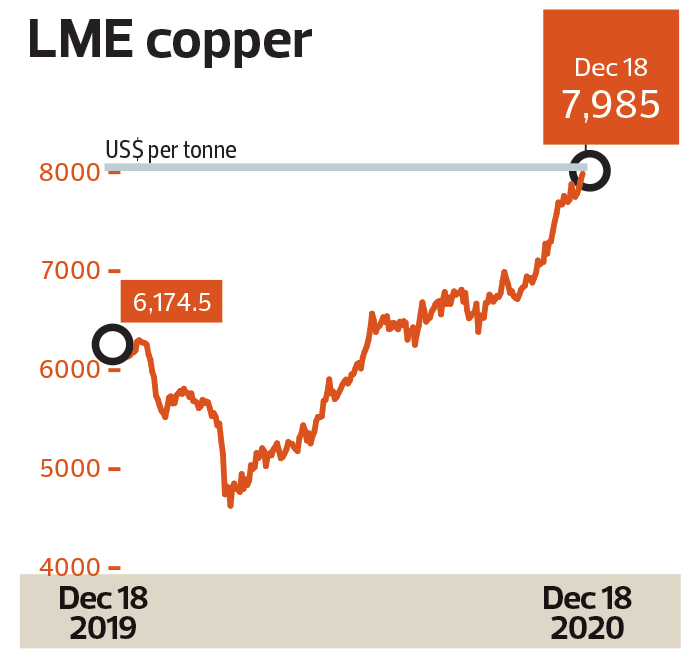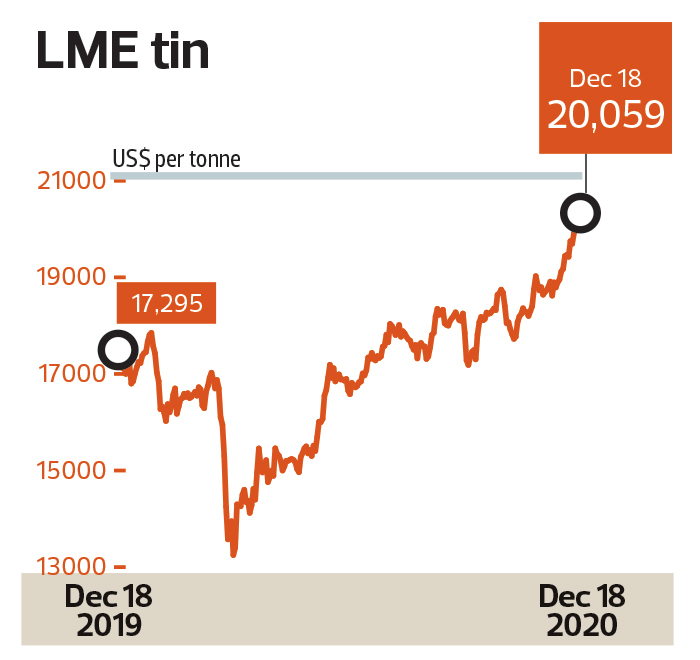
This article first appeared in Capital, The Edge Malaysia Weekly on December 28, 2020 - January 3, 2021
THE Covid-19 pandemic notwithstanding, the year 2020 has been a fairly good one for commodities, with almost all the major commodities charting decent gains year on year (y-o-y), with the exception of a few such as crude oil and Arabica coffee.
Analysts say the outlook for 2021 looks bright for commodities, with a key driver of the recovery being an improvement in demand from China.
“Looking ahead to 2021, we expect the commodities complex to continue to move higher. A further recovery in economies around the world should prove supportive, while there is the potential for further stimulus. Significant growth in money supply, rock-bottom interest rates and fiscal stimulus have boosted inflation expectations. Therefore, we expect to see more money flowing into commodities, with speculators boosting their long position, notably in metals and agricultural commodities,” says ING head of commodities strategy Warren Patterson and senior commodities strategist Wenyu Yao in their note.
“Oil has also seen some speculative interest, but there is clearly room for more buying in the energy space over 2021.”
Here, we take a closer look at the performance of some of these commodities in 2020, and what 2021 has in store for them.
Brent crude oil
Price as at Dec 18, 2020: US$52 per barrel
⇩ 21% y-o-y
Oil prices kicked off with much promise in 2020, trading at US$68 per barrel in early January. The pandemic proved, however, to be a strong kryptonite for the commodity, with international benchmark Brent crude oil prices sinking to as low as US$19 per barrel in April as the number of Covid-19 cases across the globe climbed, and as more countries went into lockdown to contain the spread of the disease.
Oil’s US benchmark, the West Texas intermediate, had an even tougher time as it slipped into negative territory at -US$37 per barrel for the first time in the history of oil prices. The plunge to negative territory was attributed to a lack of storage capacity at Cushing in Payne County, Oklahoma, coupled with May futures reaching expiry.
Oil prices slowly picked up in the second half of the year as countries eased their lockdown restrictions, reaching US$50 per barrel in early December.
OCBC economist Howie Lee expects the demand for crude oil to recover gradually in 2021. “Our model suggests that Brent may end the year at US$55 per barrel, but the supply surplus in the first half means oil may trade within the sub-US$40s range in the first half of 2021. We expect Brent to trade within US$45 to US$50 per barrel for the first six months of 2021, and then US$50 to US$55 per barrel for the remaining six months.
“The upper end of our forecast suggests Brent may rise as high as US$64 per barrel, but given the still-unpredictable recovery path of the global economy, we do not think oil will trade materially above US$60 per barrel next year.”
ING’s Patterson and Yao expect the oil market to draw down its inventories throughout 2021, as demand continues to recover. They say the key risk was initially around the first quarter of next year, but the Organization of the Petroleum Exporting Countries Plus (Opec+) alliance has addressed this with its recently revised deal to cut production.
“We forecast that Brent will average US$55 per barrel over 2021 and likely end 2021 in the region of US$60 per barrel. This view is dependent on a vaccine allowing demand to continue recovering, along with the Opec+ deal holding through the whole of 2021,” say Patterson and Yao.
Crude palm oil (CPO)
Price as at Dec 18, 2020: RM3,663 per tonne
⇧ 29% y-o-y
CPO prices have had a decent run in 2020, owing to lower inventories because of labour shortages as a result of the pandemic, as well as higher prices of CPO substitute soybean oil, owing to the dry weather in South America, which threatened the soybean crops there. The price of soybean oil has increased 15% y-o-y to US$0.39 per pound.
Nevertheless, OCBC’s Lee expects palm oil prices to trend lower next year, ending 2021 at RM2,600 per tonne and trading at an average of RM2,775 per tonne. “Supply disruptions in Malaysia and Indonesia have contrived to send CPO prices to their highest in eight years in December 2020, but we think this is unlikely to last.
“Higher production from La Niña, a return to labour normalcy in palm plantations on a vaccine distribution, and [that] the above-average premium palm is currently trading above gasoil and soyoil suggest CPO prices are in need of a correction next year,” he says.
The Council of Palm Oil Producing Countries (CPOPC) says palm oil prices are likely to stay high in the first half of 2021, amid less soybean crushing in Argentina and rising sunflower oil prices.
“Another key factor to watch is the weather pattern and the severity of La Niña. Ongoing La Niña heavy rainfall has started to disrupt output in Southeast Asian palm oil-producing countries. This will subdue global supply until the first quarter of 2021. Towards the second half of 2021, adequate rainfall and better crop management incentivised by the current high palm oil prices will significantly boost production,” CPOPC says in its “Palm Oil Supply and Demand Outlook Report 2021”.
Gold
Price as at Dec 18, 2020: US$1,881 per ounce
⇧ 28% y-o-y
The yellow metal, a safe haven for risk-averse investors especially during recessions, enjoyed a good run in 2020, with prices surpassing US$2,000 per ounce, reaching a record high of US$2,063 per ounce in early August. Prices then slowly retreated to US$1,885 per ounce in mid-December.
“Gold managed to trade to record highs this year, with a move to safety amid the uncertainty. Falling yields and a weaker US dollar only provided a further boost. While vaccine optimism abounds, we still believe gold prices will trend higher next year amid growing inflation expectations and negative real yields,” says ING’s Patterson and Yao.
They add that pent-up demand is likely to push up physical demand for gold firmly in 2021, as consumers return to the market, especially for festival and wedding demands. “While higher prices might deter some consumers, government stimulus and an increase in disposable income are likely to provide enough liquidity for consumers to increase gold purchases,” they say.
ING expects gold prices to average US$2,000 per ounce in the third quarter of 2020 and inch higher to US$2,020 per ounce in the fourth quarter, before averaging the year at US$1,965 per ounce.
OCBC’s Lee concurs. “Gold ought to benefit from the sustained fiscal and monetary support in major economies next year, especially within the US and European Union. While rising risk sentiment may prove to be an early headwind for gold’s allure as a safe-haven asset, the triple combination of a weak US dollar, low yields and rising inflation expectations should continue to drive gold higher.
“We expect gold to continue rising through the year and trade above US$2,000 per ounce from 2Q2021 through 4Q2021.”
Iron ore
Price as at Dec 18, 2020: US$162 per tonne
⇧ 77% y-o-y
Iron ore prices have risen to their highest levels since 2011 and are up 77% y-o-y at US$162 per tonne.
According to a report by Bloomberg Quint, iron ore prices have risen the most among ferrous commodities so far this year globally, as demand for the key raw material used in steelmaking rose once economies around the world restarted following the easing of Covid-19-related restrictions.
OCBC’s Lee expects iron ore prices to trend higher in 2021, given the robust demand from China for its fiscal infrastructure projects. “The pressure to replenish Chinese steel inventories in early 2021 may see increased demand for iron ore imports into China, which may drive iron ore to US$175 per tonne by late 1Q2021.
“A supply shock — extreme wet weather or cyclones in Australia, or a shutdown of Brazilian mines on safety concerns — may send iron ore above US$200 per tonne. Steel rebar at RMB5,000 per tonne may provide the leeway for iron ore to test US$200 per tonne, although smaller steel mills may be running negative margins at such price levels.”
ING’s Patterson and Yao expect an increase of 80 to 100 tonnes in iron ore supply next year, while there is still plenty of uncertainty over the demand outlook. “Quick rollouts of vaccines could see a more robust recovery in demand, which is likely to keep prices well supported above US$100 per tonne. However, a gradual rollout means we would probably see more lacklustre demand growth, which could push the iron ore market back into surplus, weighing on prices.”
Copper
Price as at Dec 18, 2020: US$7,985 per tonne
⇧ 29% y-o-y
Copper prices have surged 61% since trading at US$4,951 per tonne in March, owing to mine production disruptions in Latin America because of Covid-19 and improved manufacturing activity in the US, China and the eurozone.
A report by Mining.com also states that copper is likely to benefit from the growing electric vehicle market because it is used in electrical wiring.
OCBC’s Lee says copper demand may have yet to peak vis-à-vis steel, while supply also remains a big concern, given the concentration of production in South American economies. “It also remains a question mark if the under-investment in copper mine capex could impede mining output beyond 2021. We think copper may peak at US$8,800 per tonne by end-2021.”
Much of the bull narrative for copper has already been priced in, says ING’s Patterson and Yao. “However, the market will need a favourable macro environment to continue with its current trend, along with further weakness in the US dollar, which is what we expect. We expect copper [prices] to average US$7,400 per tonne over 2021.”
Other commodities
Wheat prices have rallied 28% since trading at US$4.92 per bushel in June, to as high as US$6.32 per bushel in October. The US Department of Agriculture’s Foreign Agricultural Service said in its “Grain: World Markets and Trade” report that world wheat prices remained firm this month, owing mostly to the impact of dry weather on the start of the growing season in the Northern Hemisphere and unfavourable production conditions in Argentina.
Rabobank expects global import demand for wheat to dampen slightly from 2Q2021, as a likely vaccine and back-to-normal economic activity will quiet fears and help avoid stock accumulation.
“Chinese imports of wheat are expected to continue to be high compared with historic levels, but capped below the quota of 9.6 million tonnes. Prices may find a weaker floor in 3Q2021 and 4Q2021 as improving weather, declining fund interest and less appetite for stockpiling by governments and food processors will lead to a more relaxed situation,” says Rabobank.
One of Malaysia’s oldest commodities, tin also had a decent performance in 2020.
Tin prices have surged 16% y-o-y to US$20,059 per tonne, owing mainly to a recovery in demand from China. The world’s third-largest tin producer Malaysia Smelting Corp Bhd sees tin prices extending their rally to 2021 on the back of a recovery in demand for consumer electronic goods, following improving sentiment on encouraging Covid-19 vaccine news.
At the same time, more tin applications are being discovered with technological advancements. These applications include the use of tin in lithium-ion batteries for electric vehicles, which is expected to grow rapidly in the future.
Save by subscribing to us for your print and/or digital copy.
P/S: The Edge is also available on Apple's App Store and Android's Google Play.
- Exsim cancels Aperia data centre contract, trying to secure unnamed Japanese firm
- Capital A, AirAsia X, Sunway Construction, KJTS, KIP REIT, Magni-Tech, AEON, CIMB, PPB, Vizione, Kerjaya Prospek Property, OB Holdings
- PM's involvement seals Mida-ARM Holdings strategic cooperation
- Wall St edges higher after services sector data; tariffs in focus
- OB Holdings sued over alleged IP infringement dispute







